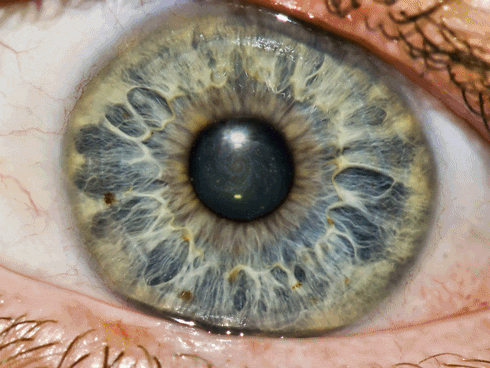Meet the Two Brothers Making Millions Off the Refugee Crisis in Scandinavia
It’s a scene that could possibly warm even the two-sizes-too-small heart of the Grinch. Here in a little village in Norway, as dusky midday light filters in through the forest outside a classroom, a half-dozen Afghan teenagers hunch over a long wooden table, assiduously scissoring colored sheets of construction paper.
Kristian (left) and Roger Adolfsen at their office in Oslo. The brothers own Hero Norway.
Are they happy to be here?
“It is calm and peaceful,” says Bilal, 15, in Pashto.
“It is nice,” says Ahmad, also 15, “but why isn’t there a cricket pitch?”
Except there’s this other guy in the room, standing off to the side, almost invisible as he handles incoming e-mail on his smartphone. Kristian Adolfsen, 55, wears a V-neck sweater, a striped button-down, and glasses. This is his first visit to this refugee center in Hvalstad, but he owns the operation with his brother, Roger, 51, and they run 90 such centers in Norway and 10 more in Sweden. Refugees represent a huge opportunity for them; the Adolfsens’ Oslo-based company, Hero Norway, is the leader of a burgeoning Scandinavian industry that charges the Norwegian and Swedish governments a fixed fee—$31 to $75 per person per night in Norway—to house and feed refugees.
For 2015, Hero Norway expects revenue of $63 million, with profits of 3.5 percent. In the rest of Europe, where asylum seekers typically are cared for by nongovernmental organizations such as the Red Cross, only one for-profit is larger than the Adolfsens’ operation, ORS Services, a Swiss company that in 2014 generated $99 million in profit caring for refugees in Switzerland, Austria, and Germany. (ORS won’t disclose its 2015 profits.)
The Adolfsens have succeeded in part because they have a background in hospitality. In the three decades since they founded Adolfsen Group, Kristian and Roger have built an $800 million-a-year network of businesses that includes preschools and nursing homes, as well as hotels, apartment buildings, cruise lines, and ski resorts. The two entered the refugee sector in May 2014, when they paid a Danish company, ISS Facility Services, $22 million for Hero Norway, a 27-year-old company that ran 32 refugee centers.
For-profits now care for about 90 percent of Norway’s refugees. A gold rush has commenced, and it’s also a bit of a circus. Just outside Oslo, a savvy entrepreneur named Ola Moe recently rented a vacant hospital for $10,000 a month, did minimal upgrades, and began charging the government $460,000 a month to house and feed 200 refugees. At a refugee center in Southern Norway, 50 resident asylum seekers went on a two-hour march in November to protest the poor food, prompting one politician, an Iranian Norwegian named Mazyar Keshvari, to proclaim, “These ungrateful people should immediately leave the country.”
Amid such controversy, the Adolfsens appear like poised professionals. In press photographs, they flash can-do smiles as they sit before gleaming conference tables in airy office towers. One Oslo paper, Dagens Naeringsliv, has called them “Norway’s least known billionaires.” Yet concerns remain. In their monetization of the refugee crisis, will the Adolfsens provide superior, more efficient havens, or will they cut corners and skimp on services to improve profits? And does their bottom-line approach threaten a depth of caring that transcends hard cash?
Roger stayed out of the cod tongue industry (by the time he came of age, his mother was weary of living in a household smelling of fish), but he soon followed his brother into competitive running and cross-country skiing. The brothers served as delivery boys, Kristian carrying groceries on his sled and Roger baked goods. Both worked as salesmen in the TV shop, and during the late 1970s—as Norwegian conservative Kare Willoch rose to power, eventually becoming prime minister in 1981—the brothers grew infectiously excited over his staunch opposition to the social democratic state that took root in Norway after World War II.
Kristian and Roger ran for the Andenes City Council as teenagers. Both won seats and fought for the privatization of road services and garbage pickup in Andenes. “My first speech was about privatizing the road grading,” Kristian says. “I spent hours writing and correcting many times what I would say. I tried to memorize every word.”
When the Adolfsens made their first major business move in 1991, purchasing the 44-room Andrikken Hotel in Andenes, the gesture had an almost holy resonance: They were buying the very hotel their father had built. In 1981, Kolbjorn had lost the business to bankruptcy. But he kept its giant sign in his basement. It depicted a long-necked duck flying into the midnight sun. The brothers rehung it—then staffed the hotel with old friends from Andenes, establishing a tone. “We have a coast culture in our companies,” Kristian says. “We are professional but informal, and we base everything on trust. When you grow up in a small place, you can’t do anything wrong. You get a bad reputation.”
Over the next decade, the Adolfsens built Norlandia Hotel Group, which now manages about 30 establishments, many of them Best Westerns, throughout Norway and Sweden. As the Norwegian government started allowing private companies to make money on social welfare work, they ventured into nursing homes, then preschools. “We are like sportsmen,” Kristian says calmly and clinically, explaining his and Roger’s drive. “We set goals, and then we reach our goals, and then we have to set new goals. It is not about the money. It is about the excitement.”
In Orkerod’s first 12 months under Norlandia’s guidance, 19 nurses quit. In a recent op-ed in Moss Avis, Nitter joined two other Orkerod doctors in complaining that the clinic’s excellence, built over its first 13 years of operation, had been “torn down in a single year.”
Kristian denies that the quality of the service at Orkerod declined and argues that departed staffers were disgruntled simply because Norlandia shook them from long-standing work habits. “These were people who’d been there for many years,” he says. “They were used to doing things their way, and then we made changes. It’s a lot more demanding to work for a private company because we focus on providing better quality at lower prices.”
Ny Tid’s figures came from an anonymous source within UDI, a 20-year veteran at the agency.
When I met with this man, he said of Link, “Every year they overestimate what services will cost them. That is how the game is played, and if new operators don’t understand that, they’re going down.” Hallstein Saunes, the leader for Link’s refugee centers, disputes the figures presented by Ny Tid, calling the paper’s interpretation of them “misleading” and saying that Link didn’t skimp on social services. Rather, he says, it saved elsewhere—on utilities, for instance. “Our aim,” he says, “is to operate good reception centers within the financial framework of our agreements as we develop the company and contribute towards solving an important task in our society.”
UDI’s monitoring of corruption is minimal, according to the UDI source. “We can only concentrate on opening new refugee centers,” he said. He had no special knowledge on Hero Norway, but in discussing the company, he was uncharacteristically sunny. “They’ve been a good partner for UDI,” he said. “They’re very flexible. When we need them to expand, they do. It’s easy.”
It’s not clear whether others will embrace or reject the Adolfsens’ refugee riches, but several insiders predict that Norway’s Parliament will allow refugee entrepreneurs to continue but will cap their earnings. “I wish we could operate with only NGOs and municipalities running refugee centers,” says Marte Gerhardsen, the director of Oslo-based Tankesmien Agenda, a think tank closely aligned with Norway’s Labor Party, “but right now, right here, we need Hero, and it’s totally illogical to say they can’t make profits. That would be like Prohibition in America—it won’t work.”
She adds, “we do need to regulate them, though.” Gerhardsen argues that private operators be limited to a 3 percent profit margin. The Adolfsens claim that theirs is 3.5 percent, but Herning calls that figure “highly unlikely. All the other refugee companies that I’ve looked at have a much higher profit margin.” She says that in handling revenue from nursery schools and nursing homes, the Adolfsens have played a shell game, shifting profits from one business within their conglomerate to another. “I wouldn’t be surprised if they were doing that for Hero as well,” she says.
Rich people always say things like this, of course, but coming from Kristian, the humble talk is somewhat believable. For a man who could reasonably cast himself as the Donald of Norway, he’s a remarkably bland and polite presence, even by taciturn Norwegian standards. When we confer with the heads of three refugee centers, he scarcely speaks. He doesn’t harry anyone, and he asks very few questions. His focus seems far away, ensconced in a netherworld of ledgers and spreadsheets.
He and Roger are almost monklike in their devotion to business. Both work about 70 hours a week, following achingly methodical routines. “Monday to Thursday,” Kristian says, “I work in my office at home until 1 a.m. I leave for work between 7:20 and 7:25. When I am on vacation, I work for an hour in the morning and an hour at night.”
Right now, we’re driving to Hero Norway’s biggest refugee center, in Rade near the Swedish border.
In recent weeks up to 1,200 new arrivals have crowded into a vacated supermarket, living in indoor tents as they wait for interviews with the Norwegian border police. I feel like I’m descending into the maw of history. I’m aware now of all the wars, the bloodshed, the human struggle that have brought so many to remote Rade, which is little more than a scattering of ugly chain stores by the highway. Kristian’s remarks drift toward the international only once, however: when he thrills over a new app, SayHi, which translates spoken words into more than 100 languages. “It will save so much money,” he says.
Next year, Hero Norway hopes to open 5 to 10 refugee centers in Sweden.
The campaign could be spotted with difficulties. In Sweden, arsonists have torched more than 40 centers since July, in part because in 2015 Sweden accepted about 160,000 asylum seekers, more per capita than any other European nation. Still, the prospects for Hero Norway’s continued success are high. Neither Sweden nor Norway has plans to stanch the flow of newcomers, and the Swedish government has said it will spend up to 30 percent of its 2016 foreign aid budget on resettling refugees.
An Iraqi Kurd tells me he escaped clan warfare that resulted in him being beaten with sticks. He lifts his shirt and shows me the scars on his ribs.
Kristian stands back, aloof, chatting only with administrators, conferring about their plans to build a health clinic here to screen refugees for tuberculosis and other diseases.
In time, we’re given a tour by the camp’s director. Helge Ekelund is a large, hulking fellow with a tight ponytail, and he’s a no-nonsense guy who’s well aware that the great migration to Norway can continue only if there are functioning toilets.
“Here are the tents we got free from the army,” he says. “Here is where we take away everyone’s clothes. We put the clothes in these freezers here, to kill off the bedbugs.” The freezer is set at -30F, he says. The clothes stay in there for 48 hours, while the asylum seekers wear borrowed garments.
When Kristian and I step back into the rain, I ask him what about the refugee center intrigued him the most. “The freezers,” he says. “I thought those were interesting.”
We begin driving north. It’s 3 p.m. There are still 10 hours to go before his workday is over.




























